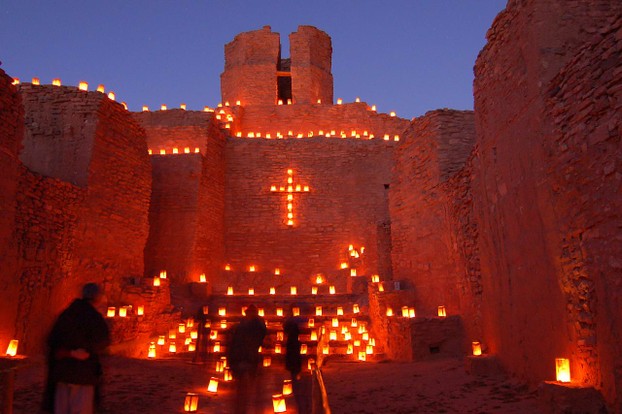Las Posadas ("Inns") depicts the fruitless search of Mary and Joseph for a room in an inn.
"Mary and Joseph arrive in Bethlehem": 1906 watercolor by William Brassey Hole (November 7, 1846 - October 22, 1917)
William Hole, The Life of Jesus: Eighty Pictures (1906), No. 3: Public Domain, via Wikimedia Commons @ https://commons.wikimedia.org/wiki/File:Joseph_and_Mary_arrive_at_Bethlehem.jpg
A tradition in New Mexico calls for constructing vigil fires (luminaria) of piñon pine during Las Posadas.
Closeup of piñon pine (Pinus edulis) foliage and cones: In addition to New Mexico, piñon pine's native homeland includes northern Arizona, Colorado, eastern and central Utah, Guadalupe Mountains in westernmost Texas, and southern Wyoming.
Placitas, Sandoval County, north central New Mexico: snowpeak, CC BY 2.0, via Wikimedia Commons @ https://commons.wikimedia.org/wiki/File:Pinus_edulis_Snowpeak.jpg
In "The Night of Las Posadas," farolitos (paper-bag lanterns) illuminate the historic plaza in Santa Fe, New Mexico.
farolitos at the 17th-century San José de los Jemez Mission Church
Jemez State Monument, Sandoval County, north central New Mexico: Larry Lamsa, CC BY 2.0, via Wikimedia Commons @ https://commons.wikimedia.org/wiki/File:Farolitos,_old_church,_Jemez_State_Monument.jpg
"The Night of Las Posadas - Tomie dePaola (read aloud)" (10:56) ~ reading with artwork (without text) from book
URL: https://www.youtube.com/watch?v=79ArflFunZk
The procession of the posadas concludes at the Palace of the Governors
Palace of the Governors at night, Dec. 26, 2021; 105 W Palace Avenue, Santa Fe Historic District: Dicklyon, CC BY SA 4.0, via Wikimedia Commons @ https://commons.wikimedia.org/wiki/File:Palace_of_the_Governors_at_night.jpg
Tomie dePaola's signature
personal autograph collection of Wikimedia Commons User: Bradforce28: Public Domain (CC0 1.0), via Wikimedia Commons @ https://commons.wikimedia.org/wiki/File:TomiedePaola.png













 Are Hawaiian Huakai Po Nightmarchers Avenging Halloween Thursday?on 10/02/2024
Are Hawaiian Huakai Po Nightmarchers Avenging Halloween Thursday?on 10/02/2024
 Mailing Addresses for 2023 Form 4868 Extending 1040 and 1040SR April 15, 2024, Due Dateon 04/15/2024
Mailing Addresses for 2023 Form 4868 Extending 1040 and 1040SR April 15, 2024, Due Dateon 04/15/2024
 Mailing Addresses for 2023 Forms 1040 and 1040SR Filed in 2024on 04/15/2024
Mailing Addresses for 2023 Forms 1040 and 1040SR Filed in 2024on 04/15/2024
 Mailing Addresses for 2022 Form 4868 Extending 1040 and 1040SR April 18, 2023, Due Dateon 04/13/2023
Mailing Addresses for 2022 Form 4868 Extending 1040 and 1040SR April 18, 2023, Due Dateon 04/13/2023



Comments
Mira, You are welcome. Mexican and Latin American literatures are distinctive in the worlds which they create in readers' imaginations. The journey through their literatures may be challenging because of unfamiliar symbolism but it is rewarding. I hope that you are able to find the time to pursue your interest, book by book.
Yes, I had forgotten about the luminarias :) Thank you so much for spotlighting these customs and cultures! It makes me realize how much I truly want to read more Mexican and Latin American literature.
Mira, It's quite a sight to see the candlelit, sand-filled paper-bag lanterns (farolitos) and the controlled bonfires (luminarias). There's such a sense of ancientness, timelessness, and timeliness in a setting such as New Mexico. It's a new state (just since 1912) with centuries of Hispanic and Native American cultures preceding that event.
The farolitos are wonderful on those buildings.
I understand from your article that it's a tradition to go from one inn to another in reenactment of Mary and Joseph's comings and goings. Hot chocolate and cookies sounds fabulous. Wonderful custom :)